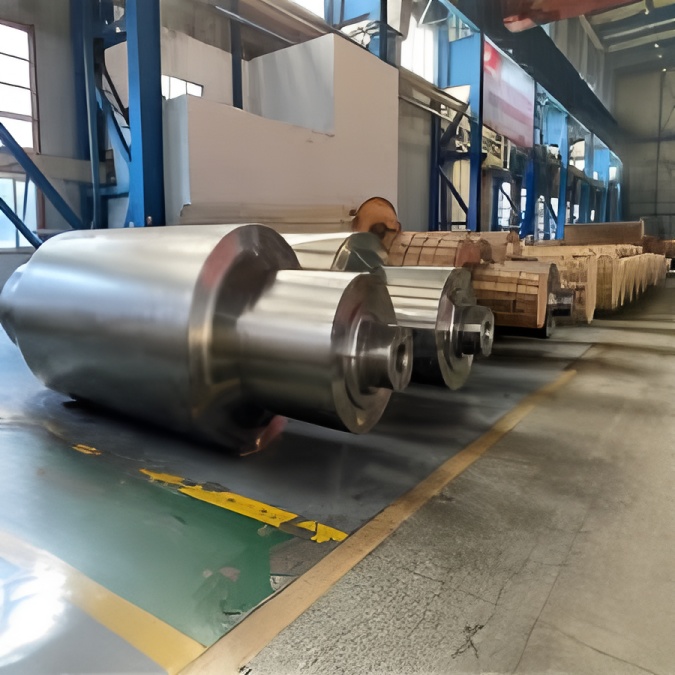Independently Developed New Mill Roll Materials
Successfully Developed Special Rolls for Finishing Mills in Wire Rod (Plain Wire) Production
For finishing rolls in wire rod mills (producing Ø6.5–Ø8 mm plain wire) with rolling speeds below 25 m/s, medium-alloy indefinite chilled centrifugal composite rolls were previously used. These not only had low single-groove tonnage but also resulted in subpar wire rod surface quality. After ongoing experimentation and improvement, the company successfully developed a specialized roll for common wire rod finishing trains—the medium-alloy chilled centrifugal composite roll (material code: L3A).
With similar alloy content and cost as the medium-alloy indefinite chilled centrifugal composite rolls, the new rolls benefit from carefully optimized chemical composition and enhanced smelting and pouring control methods. The working layer of the medium-alloy chilled centrifugal composite roll achieves a structure of sorbite, bainite, and martensite, with minimal graphite in the pure chilled layer and a body hardness as high as 75–78 HSD.
These advantages significantly improve both wear resistance (30–40% higher than before) and wire rod surface quality. This new material roll is now widely used in the K1 stand of common wire rod finishing mills and has received high praise from users. It has also been successfully applied in finishing K1 rolls for Ø10–Ø12 mm round steel, delivering excellent results.
Successfully Developed Centrifugal Rolls for Intermediate Stands in Bar and Wire Mills
In bar and wire rod mills, the intermediate rolling group carries the second highest reduction after the roughing group. These rolls require high strength and good wear resistance. Conventional medium-nickel nodular iron rolls were used in the past, but these not only incurred high costs and relatively low tensile strength but also frequently led to roll breakage.
Market research indicated that changing the roll casting method was necessary to improve internal quality and reduce cost. Comparative analysis favored centrifugal casting. The centrifugal roll features a medium-nickel indefinite chilled iron outer layer (working layer) and a high-strength nodular iron core.
After repeated trials and continuous improvement, HANI technicians identified the optimal chemical composition and body hardness for the working layer. The centrifugal rolls for bar/wire intermediate mills were successfully developed and put into mass production.
Replacing conventional medium-nickel nodular rolls with medium-nickel centrifugal rolls greatly enhanced roll core strength, essentially eliminating breakage issues. The average tensile strength of the centrifugal rolls reached 599 N/mm², compared to 449 N/mm² for conventional rolls. Additionally, roll costs decreased significantly—production cost per ton was reduced by ¥2,489.9 (a 32.63% decrease), yielding annual savings of ¥4.35 million and notable economic benefits.
Independently Developed Centrifugal Rolls for Channel Steel Finishing
Finish rolling rolls for channel steel have long been produced by conventional casting, using medium-nickel-chromium-molybdenum nodular indefinite chilled iron rolls (medium-nickel chilled nodular rolls). However, due to the deep grooves in channel steel rolls, conventional casting results in a significant hardness drop and low groove bottom hardness, leading to poor wear resistance and unsatisfactory channel steel surface quality.
Since conventional one-cast rolls use the same material throughout, it is difficult to balance core strength with surface wear resistance. Often, improving hardness and wear resistance reduces strength and causes breakage, whereas prioritizing strength results in insufficient wear resistance. This issue remained unresolved for a long time.
Some attempts used cast grooved rolls, which improve wear resistance, but the complex design of chill molds for channel steel grooved rolls made pre-casting mold preparation and post-casting iron removal very cumbersome. Material selection was also problematic: medium-nickel indefinite chilled rolls broke easily due to low strength (tensile strength 150–180 N/mm²), while medium-nickel chilled nodular rolls caused defect-like surfaces in the groove and could not be used. Thus, cast grooved rolls were never successfully adopted in channel steel finishing.
Researchers concluded that centrifugal casting could better meet channel steel finishing roll requirements. Using a dual-pour process, the centrifugal roll has an alloy nodular iron outer layer and high-strength nodular iron core, successfully balancing core strength with outer layer hardness and wear resistance.
This centrifugal roll has been practically applied at Shandong Zhangqiu Honghui Section Steel Manufacturing Co., Ltd. for single-groove rolling of 8# channel steel, confirming the successful development of centrifugal rolls for channel steel finishing.


